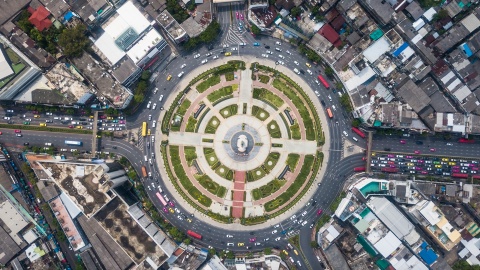
Chip Stories
Infineon's Chip Stories provide insights into applications in which Infineon components are used. Find out about interesting application examples on the mobility topics of passenger cars, micromobility, public transport, freight transport, charging infrastructure and mobility as a service.
Micromobility
Transforming urban traffic through micromobility
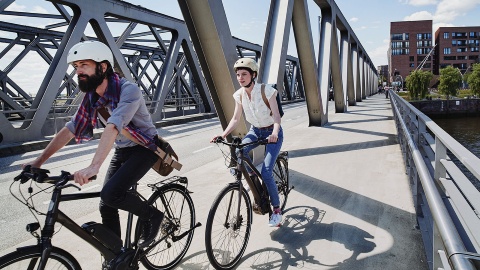
Micromobility: Pune Center of Competence
Infineon India’s Pune Center of Competence for electric two and three wheelers
India has emerged as the world’s biggest two-wheeler market.
That’s why Infineon has set up the Center of Competence (CoC) for two and three wheelers in Pune as a unique system application lab for global Infineon Technologies. It deals with new regulations on emissions and safety, progress in electrification and electric drives as well as growing customer demand. The CoC has specific objectives:
- Develop innovative system solutions for two and three wheelers with advanced technology and products to address customer pain points and reduce time-to-market
- Validate new products and solutions in real-world applications, understand application requirements in order to address product gaps
- Build system expertise in two and three wheeler EV applications for enhanced global technical customer support and build trust-based customer partnerships
Micromobility: Delivery robots
Autonomous delivery robots are a promising field for logistics companies, retailers, and customers alike. While the delivery robots market is still in its infancy, the demand for these everyday helpers is already growing rapidly.
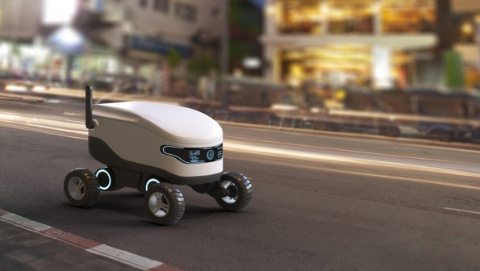
Specialized companies, many of them in Asia, are leading the way, pioneering safety standards and eventually mass production. The main reason for the significant increase in the development of delivery robots is consumer desire for quick deliveries.
Depending on the area of application, there are different robot types. For example, delivery robots, which are comparatively slow, unmanned or transporting food or other items. They are perfect for last-mile delivery. They also feature good battery life, store and transmit service information to users and use precise sensors to perform particularly demanding tasks.
Infineon provides all the electronics for these types of service robots and enables robot developers to overcome technical challenges with the help of the next generation of semiconductor technologies.
Highlights from Infineon’s portfolio include OPTIGATM Trust, OptiMOSTM, MOSFETs, gate driver ICs and DC/DC controllers.
Public transport

Public transport: Hydrogen buses
First hydrogen buses in south-east Austria to decarbonize public transport
Since August 2021, transport companies in Europe have been required to buy vehicles with alternative drives to reduce emissions.
The biggest bus operator in Austria, ÖBB Postbus, and municipal authorities in the Austrian province of Carinthia opted for hydrogen technology to start their mobility transformation. ÖBB ordered the first five hydrogen buses from Solaris hydrogen buses and will grow its hydrogen transportation fleet to 40 by 2023.
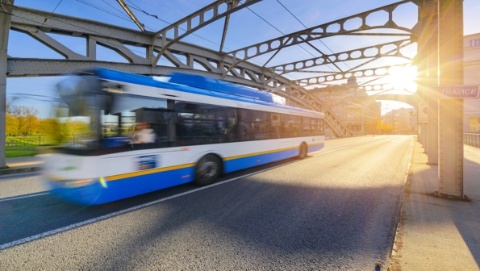
Recycled, green hydrogen for sustainable mobility
The 12-meter hydrogen-powered buses will be operated by the public transportation entity in the region of Villach. The new buses refuel with regionally and sustainably produced green hydrogen, which is recycled.
Here's how it works: After industrial use in production at the Infineon site in Villach, the hydrogen is cleaned using an innovative process and reused to power public buses. Thanks to this technology, the new buses will be able to cover about 400 km with just one tank of fuel, carry up to 74 people and reach a maximum speed of 80 km/h.
Infineon’s first hydrogen plant: Solution for a sustainable closed-loop recycling
The hydrogen, used as a carrier and process gas in semiconductor production, will be generated directly at Infineon using renewable energy sources.
Thus, Infineon's own sustainable solution will replace liquid hydrogen which was previously produced from fossil raw materials and imported from Germany by truck. In a first step, the new plant will produce 500 kg of hydrogen per day. Once fully expanded, the quantity will be increased to 800 kg.
The project will include, among other things, the first hydrogen-fueling station of the Carinthia region, as well as the addition of hydrogen-fueled vehicles to existing bus fleets. The fueling station will be designed for the refueling of heavy-duty vehicles such as buses and trucks and is scheduled to kick off in 2024.
Facts and Figures
- 337 kg of recycled hydrogen will be available every day,
- Around 4,200 bus kilometers can be driven per day,
- Up to 17 buses in the Villach area can be operated in a climate-neutral manner. That corresponds to around 1.4 million climate-neutral kilometers per year.
Public transport: Clean mobility
Clean mobility: Semiconductor solutions for quieter trams
Trams and local trains are the backbone of public transportation in rural as well as urban areas. Making them as energy-efficient, quiet and convenient as possible is therefore key to the efforts of cities and providers to achieve sustainable mobility.
In the case of trams, silicon carbide (SiC) technology offers clear advantages. It is particularly beneficial to regional trains with an innovative battery hybrid drive which can be used on rail sections with or without an overhead contact line. The technology minimizes weight, optimizes performance and boosts the efficiency of multiple units in terms of consumption and range.
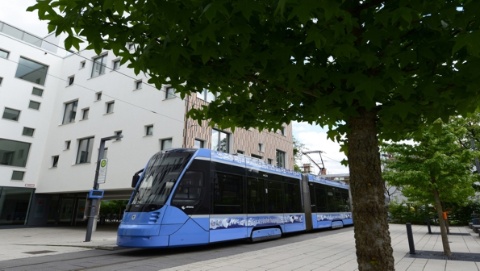
Joint field test proves the benefits of SiC technology in public transportation
Infineon has been a key player in the development of silicon carbide (SiC) technology and its qualification for use in rolling stock. For example, Infineon’s XHP 2 power modules based on SiC technology have proven their worth in a joint field test in Munich, creating benefits for manufacturers, rail operators and residents: A Siemens Avenio tram used for passenger rail service by the local German transport company MVG was equipped with XHP 2 power modules and tested in passenger service for a year, covering around 65,000 km. Siemens Mobility concluded that the use of power semiconductors based on silicon carbide made it possible to reduce the energy consumed by trams by ten percent.
At the same time, it was also possible to significantly reduce noise during operation. The tests were carried out under the European development and research project PINTA and are part of the European research initiative Shift2Rail, which aims to create a sustainable European rail system.
Higher energy efficiency thanks to silicon carbide
Implementing SiC in power modules for traction propulsion systems can also pose major challenges: In addition to an efficient and very robust SiC chip, packages that allow high switching speeds are also required, as well as interconnection technologies that enable a long service life. These are precisely the features offered by Infineon's power module: Since trains accelerate and decelerate frequently, the power cycles for semiconductors in rail applications are very demanding. Constant temperature fluctuations put stress on the interconnection technology. Infineon's .XT technology provides a solution to this challenge. The technology significantly increases the lifetime of power cycles and has been used successfully for years in other challenging applications such as wind turbines.
CoolSiC™ MOSFET chips in Infineon's XHP 2 power module enable low conversion losses while maintaining high reliability. The modules are the basis for increased energy efficiency. Infineon's XHP 2 package features low stray inductance, a symmetrical and scalable design and high current capacity. As a result, the package is ideally suited to SiC.
Freight transport
Making heavy-duty vehicles clean, safe and smart

Freight transport: Mirror module
Decentralized mirror module
Large side mirrors on commercial vehicles are an extremely important safety feature and are essential for making sure the driver has a good rear and side view.
The digital mirror system replaces the large side mirrors with two interior monitors and two external cameras mounted above the driver's cab. The aerodynamic design reduces fuel consumption by as much as 1-2 %. At the same time, the system improves the driver’s all-around view significantly and reduces the size of the blind spot. Infineon enables these manifold functions with its decentralized Electronic Control Unit.
Freight transport: Electronic Toll Collection (ETC) systems
Supporting Electronic Toll Collection (ETC) systems with secure and reliable solutions
Traffic congestion is one of the biggest challenges of urban living. To address this issue, cities are implementing smart electronic tolling systems.

Especially in city centers, charges paid by vehicles entering downtown areas can regulate the distribution of traffic volumes. Infineon’s product portfolio offers reliable solutions with high security standards for optimized support of electronic road tolling schemes. This reduces the risk of fraud and misuse. Regardless of whether the system is integrated in the license plate, attached to the windshield or uses a smart card or wearables – secure and fast vehicle identification allows a free flow of traffic.
Freight transport: Telematics
Telematics use semiconductor components that deliver performance, interoperability and security
New management systems control several key functions in today’s vehicles such as vehicle telematics (tracking and diagnostics).
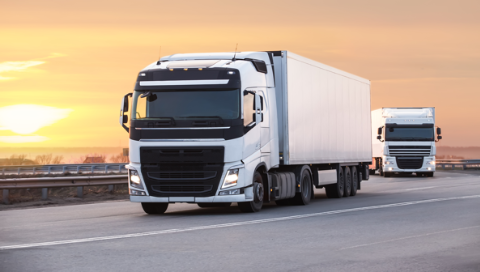
Telematics connects cars to the cloud, helps keep the driver and passengers safe, optimizes traffic flow and can place an automatic emergency call in the event of an accident. At the heart of this is an embedded hardware and software system, known as the telematics control unit. It uses semiconductor components from Infineon’s product portfolio which give the control unit the necessary flexibility to support different wireless communication standards and optimize security as well as power consumption.
Optimizing Fleet management through telematics
Fleet owners benefit greatly from telematics technology. It allows mechanics, drivers and logistic managers to make decisions regarding fleet optimization. For example, they are able to track in real time where their trucks are and what drivers are doing. They will also be able to see the actual drive time, and in some cases, also unexpected stops that may be track failures or suspicious driver activities.
Read more
Freight transport: Digital Truck-ID
The digital Truck-ID
New innovation in progress
The first manufacturers are working on solutions to give trucks a digital ID that can be used to identify them and pay for services.

New platform technologies and central user programs allow vehicles to automatically pay for road tolls, electric charging or secure boarder control solutions incl. digital customs documents — without involving or interacting with the driver.
All these factors have an impact on the cost of ownership, because in the future transport companies could benefit from secure processes and significant reduction in administrative work as they would no longer have to handle physical cards.
Read more
Freight transport: Sideguard Assist
New Sideguard Assist uses the Mirror Camera display to warn drivers visually when the system detects for example a pedestrian or cyclists in the monitored zone on the co-driver's side of the truck.

The mirrorCam and the sideguard Assist are working together and enable to avoid collisions. A Europe-wide progressive introduction of mandatory turn assist systems is planned only from July 2022 for new vehicle types and from July 2024 for new vehicles. This is why, in 2018, the Federal Ministry of Digital and Transport launched the Turn Assist Scheme to provide incentives at national level for a voluntary commitment to use turn assist systems.
Read more
Charging infrastructure
Paving the way to a seamless charging infrastructure
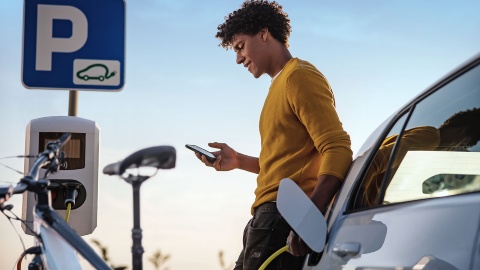
Charging infrastructure: Ultra-fast charging
Ultra-fast charging while shopping
Drivers who want to charge their electric cars while shopping can now do so in front of many supermarkets, DIY stores and furniture stores.
For the shop owners or shopping center operators, the installation of such fast-charging stations is associated with major construction measures, such as earthworks for laying the cables or pouring foundations.
The South Tyrolean manufacturer alpitronic has developed a solution for charging electric vehicles that requires considerably fewer construction measures. The new hypercharger HYC50 is the first wall-mountable system. It features an ultra-low noise level of less than 50 dBA. That way, the hypercharger can also be operated in or nearby residential areas.
The hypercharger has two fast-charging ports that can be used to charge either one vehicle at 50 kW or two vehicles simultaneously at 25 kW. The device is based on the SiC power modules MOSFET 1B and 2B in combination with the EiceDRIVER X3 from Infineon.
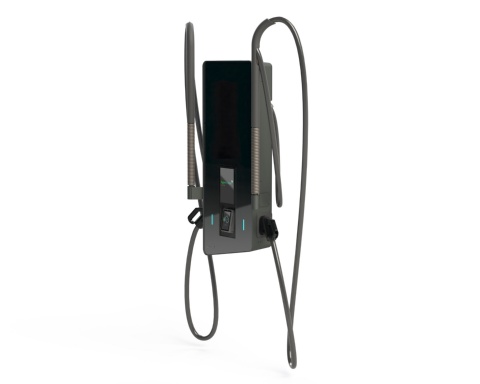
Facts and Figures
Bi-directional 50 kW (2 x 25 kW) DC-charging station for electric vehicles
The HYC50 is the first wall-mounted DC charger in this power range. By using Infineon’s CoolSiC™ technology, the power density has been increased by 50% and noise level has been reduced from 65 dB to less than 50 dB. The compact design, weighting less than 100 kg, enables deployment on walls of parking garages or supermarkets without major additional construction measures like reinforced foundations.
Integrated Infineon products
- EasyPACK 1B and 2B CoolSiC™ modules with NTC temperature sensor
- EiceDRIVER™ X3 driver ICs
HYC50 technical data
- 50 kW charging on one vehicle and 2 x 25 kW parallel charging possible
- Continuous 150 A charging current
- Output voltage 50 V – 1000 V
- Best in class efficiency > 97% (*)
- In- and outdoor installation
- Weight < 100 kg (*)
- Ultra low noise level < 50dBA (*)
- V2G ready (**)
(*) preliminary data to be verified
(**) V2G stands for “vehicle-to-grid". This technology makes it possible to feed energy from electric vehicle batteries back into the energy system.
Charging infrastructure: Di-directional charging
Electric cars as buffer storage for solar power: Infineon and Delta enable bi-directional charging at home
Electric mobility has to be seen holistically to make sure it can contribute as much as possible to decarbonization.

Protecting both environment and wallet with bi-directional charging
Electric mobility has to be seen holistically to make sure it can contribute as much as possible to decarbonization: This involves the whole energy supply chain, from green power generation and transmission to efficient consumption and intelligent storage. Among other things electric storage systems are a key building block in compensating for the fluctuating availability of renewables to stabilize grids.
One innovative technology here that can make a big difference is bidirectional charging. It works like this: Homeowners, for example, can store solar power from their photovoltaic system in electric cars and home batteries first, before they feed it back into the home grid to power household appliances in the evening hours or when power is needed and the sun is not shining. Assuming that single-family homes consume an average of 10 to 15 kWh of energy per day, a fully charged car battery with a capacity of 30 to 100 kWh can theoretically bridge a few days as a backup power solution. Homeowners thus gain low-cost electricity as well as more power supply independence.
Three-in-one system for bi-directional charging
Infineon’s solutions for bidirectional charging make it possible for electric car users to charge solar power at home at low cost and use their vehicle as buffer storage system at the same time. To enable this, Infineon has developed a three-in-one system together with Delta Electronics, a Taiwan-based leading provider of power supply and energy management solutions. The system integrates a solar unit, home storage and charging station. Thanks to bi-directional inverters, the car now also becomes a buffer storage unit or the home’s backup power supply. Looking ahead, bi-directional energy flows will make it possible to realize further Vehicle-to-Home (V2H) and Vehicle-to-Grid (V2G) solutions.
Compound material SiC cuts losses by about half when converting electricity
With an output power of about 10 kW, Delta’s new system allows a maximum continuous current of 34 A and achieves peak efficiencies of more than 97.5 percent. Energy-efficient Infineon power semiconductor components made of silicon carbide (SiC) are used to increase power density. Compared to silicon-based semiconductors, the compound material SiC reduces energy losses by around half when converting electricity and cuts the size of charging stations by about 30 percent. SiC makes photovoltaic systems more efficient, shortens charging times at fast-charging stations and wall boxes and increases the range of electric cars by five to ten percent.
Mobility as a Service
Shaping smart cities with smart mobility services

Mobility as a Service: CIPURSE™
Enabling a more seamless public transportation experience in South Africa – based on CIPURSE™
Public transportation in South Africa faces various challenges. The majority of train stations in South Africa have no gates, and the QR code paper tickets used are highly vulnerable to fraud, making fare evasion a widespread problem.
In addition to the trains, there are public buses and, most significantly, hundreds of thousands of minibus taxis carrying 15 to 20 million passengers every day. They account for the transportation of 69 % of South Africans. To make these different means of transportation more interoperable and to increase efficiency and performance, operators, transport authorities and customers have been calling for a single smartcard ticket solution for a long time.
Infineon is ready to meet this demand for multi-application cards with contactless functionality. Our products are based on the CIPURSE™ standard, which is driven by the international OSPT Alliance and enables the adoption of open standards in transportation ticketing. The CIPURSE™ standard allows interoperability across secured, cost-effective and flexible multi-application fare collection schemes. Infineon is the world’s first supplier of a complete CIPURSE™-certified product portfolio for secured, contactless cards supporting and combining public transportation ticketing, micro-payments, authentication and access.
Our CIPURSE™-certified products offer secured, hardware-based storage of AES-128 keys, enabling 3-pass mutual authentication and secured communication. Commands and data can be secured using the CIPURSE™ cryptographic protocol. In addition, our CIPURSE™-certified products are ideal for NFC applications running on standard infrastructures compliant with the NFC Forum Type 4 Tag Technical Specification.
